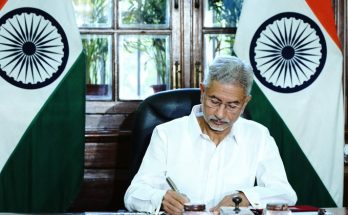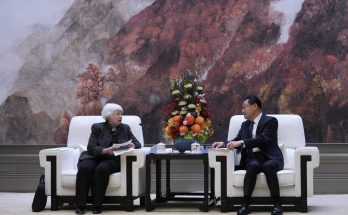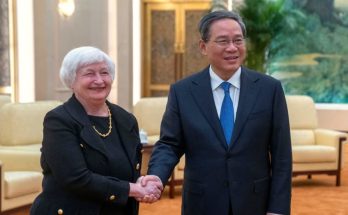 The first Xi-Abe meeting in Beijing on the sideline of APEC summit is the much needed constructive development in China-Japan relations which is navigating through one of the most difficult times since the nationalization of the contested Senkaku/Diaoyu Islands in September 2012. While this meeting alone cannot undo the prevailing hostility between these two Asian powers, it is nevertheless a welcome step since both the two country leadership agreed to cultivate political trust. The biggest take away from this summit is the Four-Point Principled Agreement on Handling and Improving Bilateral Relations. This agreement enables reviving of political, diplomatic and security dialogue along with institution of crisis management mechanisms to avert incidents in the East China Sea.
The first Xi-Abe meeting in Beijing on the sideline of APEC summit is the much needed constructive development in China-Japan relations which is navigating through one of the most difficult times since the nationalization of the contested Senkaku/Diaoyu Islands in September 2012. While this meeting alone cannot undo the prevailing hostility between these two Asian powers, it is nevertheless a welcome step since both the two country leadership agreed to cultivate political trust. The biggest take away from this summit is the Four-Point Principled Agreement on Handling and Improving Bilateral Relations. This agreement enables reviving of political, diplomatic and security dialogue along with institution of crisis management mechanisms to avert incidents in the East China Sea.
The Four-point Agreement is a much needed confidence-building measure between China and Japan. While Japan officially maintains that no territorial dispute exists, China wants a categorical acknowledgement of the dispute besides assurance concerning Abe’s restrain on the Yasukuni Shrine. Months of difficult negotiation led to a carefully crafted agreement underscoring ‘different positions’ vis-à-vis Senkaku/Diaoyu Islands, thus catering to the sentiments of their respective domestic constituencies. Moreover, on the Yasukuni Shrine, China and Japan has agreed on ‘overcoming political obstacles’ in the spirit of ‘facing history squarely and looking forward to the future’. While the agreement reflects certain ambiguity, it is a positive step towards gradually enabling dialogue and consultation between these two Asian powers.
Escalation of tension has scarred the relation between these two neighbours in recent times. Abe has systematically employed the China threat theory while underscoring the severe security environment surrounding Japan and articulated his country’s position on various occasions including the 13th Shangri-La Dialogue. China has also methodically cultivated anti-Japanese agenda and argued that Abe is fabricating a China threat to justify his own militarist ambitions. There were repeated violation of each other’s territorial water and airspace, alleged targeting of Chinese radars at the Maritime Self-Defense Force (MSDF) destroyer in the East China Sea, outlining of Chinese ADIZ, unfolding reorientation of the pacifist constitution and major shifts in Japanese security policy. The historical baggage inflicted by Imperial Japan, sentiments attached to Abe’s December 2013 Yasukuni Shrine visit, mounting anti-Japanese emotions triggered by the approaching 70th anniversary of end of World War II, contested claims in the East China Sea, and asymmetrical power politics has affected regional peace and stability.
The fallout of this mutual antagonism has been reflected in the trade and economic ties between the two countries. Intensification of the conflict has negatively affected the business interests of the world’s second and third largest economies. There is enormous pressure from the business lobbies to undo the downward trend in bilateral trade – Japan’s trade with China increased 14.3% to US$344.9 billion in 2011, but declined 3.3% to US$333.664 billioni in 2012 and 6.5% to US$311.995 billion in 2013. While Japan wants China as an important export market, Chinese exports depend on parts originating from Japan. Riots in China following the nationalization of the contested islands affected Japanese businesses. Meanwhile, China cannot afford to lose the investments and technology transfers facilitated by the Japanese companies operating in China.
The recent Xi-Abe meeting is also significant for the US. Earlier the US expressed concern regarding the escalation of power struggle between China and Japan bearing implications for the regional peace and stability. Japan is conscious of the prevailing fear of entrapment rationale in the US strategic community pertaining to the Senkaku/Diaoyu Islands in the East China Sea. While the scope of Article 5 of the security treaty obligations extends to all the territories under the administration of Japan, including the contested Senkaku Islands, US is anxious that it may get entangled in a clash with China with whom it is nurturing new power equation. Additionally, the US’ military preoccupations in the Middle East and Central Asia, and anxiety over cutbacks in the US defense budget raised Japanese worries vis-à-vis US obligation.
Stabilizing China-Japan bilateral relations is critical for peace in the East Asia. It has to be seen how this four-point agreement will translate into action. Japan is heading for elections on December 14 and the ruling Liberal Democratic Party is most likely to retain power. It will be unrealistic to assume that significant progress on the contentious history and sovereignty row could be resolved following just one summit meeting. Nevertheless, the intentions to gradually develop a mutually beneficial strategic partnership founded on the four basic political documents, including the 1972 China-Japan Joint Statement; the 1978 China-Japan Treaty of Peace and Friendship; the 1998 China-Japan Joint Declaration; and the 2008 Joint Statement on Advancing Strategic and Mutually-Beneficial Relations in a Comprehensive Wayii underlines a considerable leap in China-Japan relations.
Notes
Analysis of Japan-China Trade in 2013 and outlook for 2014, Japan External Trade Organization, February 28, 2014
https://www.jetro.go.jp/en/news/releases/20140228009-news accessed on November 18, 2014
Yang Jiechi Meets National Security Advisor of Japan Shotaro Yachi, China and Japan Reach Four-Point Principled Agreement on Handling and Improving Bilateral Relations, Ministry of Foreign Affairs of People’s Republic of China, November 7, 2014
http://www.fmprc.gov.cn/mfa_eng/zxxx_662805/t1208360.shtml accessed on November 18, 2014
Courtesy: IDSA
Author Profile
- India Writes Network (www.indiawrites.org) is an emerging think tank and a media-publishing company focused on international affairs & the India Story. Centre for Global India Insights is the research arm of India Writes Network. To subscribe to India and the World, write to editor@indiawrites.org. A venture of TGII Media Private Limited, a leading media, publishing and consultancy company, IWN has carved a niche for balanced and exhaustive reporting and analysis of international affairs. Eminent personalities, politicians, diplomats, authors, strategy gurus and news-makers have contributed to India Writes Network, as also “India and the World,” a magazine focused on global affairs.
Latest entries
 In ConversationJuly 26, 2024India-Italy defence collaboration can extend to third countries: Anil Wadhwa
In ConversationJuly 26, 2024India-Italy defence collaboration can extend to third countries: Anil Wadhwa In ConversationJuly 23, 2024Italy views India as a key partner in Indo-Pacific: Vani Rao
In ConversationJuly 23, 2024Italy views India as a key partner in Indo-Pacific: Vani Rao DiplomacyJune 29, 2024First BRICS unveils a roadmap for boosting tourism among emerging economies
DiplomacyJune 29, 2024First BRICS unveils a roadmap for boosting tourism among emerging economies India and the WorldJune 11, 2024On Day 1, Jaishankar focuses on resolving standoff with China
India and the WorldJune 11, 2024On Day 1, Jaishankar focuses on resolving standoff with China






